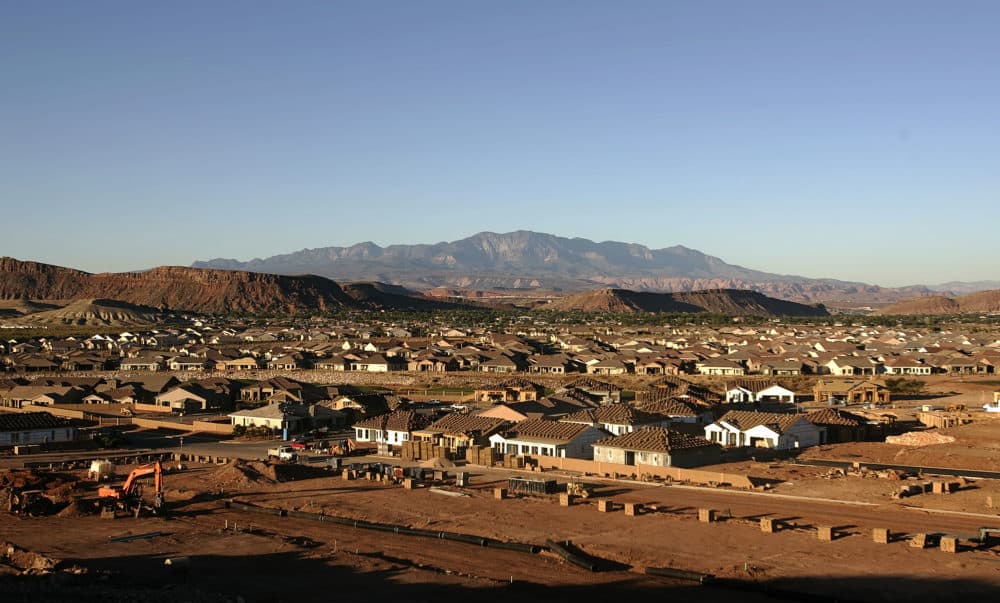Advertisement
As Home Prices Soar, Utah Lawmakers Want To Help Low-Income Residents Pay Their Rent
Resume
A housing affordability crisis is sweeping cities across the U.S.
It’s not just San Francisco and New York — other urban areas, such as midsize cities in Utah, Montana and New Mexico, are also taking a hit.
The most salient issue in the current housing market is the lack of supply, says Chris Herbert, managing director of the Joint Center for Housing Studies at Harvard University.
After the recession, household growth and housing construction slowed. But in the past five years, he says, the rate at which people are looking for housing has dramatically increased. In the U.S., an estimated 1.4 million people a year are looking for housing, he says.
“We're just not building that much housing,” Herbert says. “Last year, we built 1.2 million housing units, not enough to keep up with that demand. And that's putting great pressure on housing prices.”
A shortage of workers is one reason why more buildings aren’t being constructed to keep up with demand, he says, along with expensive land prices, housing-development approval and strict regulations regarding high-density housing.
Mountain states encounter challenging market dynamics, partially due to their healthy economies and the beauty of the land, he says. The enormous demand, in part, can also be attributed to workers resettling from expensive cities, such as San Francisco and Seattle.
“If you look at employment, particularly in Utah and Nevada, the share of jobs that are in the tech sector is high and growing,” he says. “Those are some of the places where tech jobs have been growing the fastest over the last eight years. And so that's boosting demand by people who are making good salaries.”
Earlier this year, the Sante Fe New Mexican pointed out that a person earning Sante Fe’s median salary — around $44,000 a year — would have to use 57% of their income to pay the mortgage on a median-priced home.
And in Salt Lake County, median prices for single-family homes hit an all-time high this year, surpassing $381,000.
The problem here is two-fold, Herbert explains. When housing prices are “outstripping incomes,” it proves more difficult to qualify for bank loans and harder to save for the down payment and mortgage.
Land prices and impact fees can make it difficult to build affordable housing, he says. Cities levy impact fees on developers to pay for infrastructure like roads, sewers and public schools.
In October, the mayor of Reno, Nevada tried to spur the permitting of 1,000 new homes in 120 days by delaying some of those fees. Policy shifts like this are being enacted in some cities to address the affordability crisis.
For local policymakers trying to tackle affordability in their town or city, Herbert suggests taking a close look at the entire process — fees and all — for land approval, and what restrictions might be causing developers to think twice about building. He also suggests land could be used more efficiently by creating smart, high-density housing, something he calls “missing middle housing.”
“Rather than just single-family homes and giant apartment buildings, we need things in between that are a more efficient use of land and can be more affordable,” he says.
But regulatory processes take time. The breaking point, he says, may be when housing becomes “so unaffordable” that people can’t afford to buy homes and would ultimately force sellers to lower prices.
In Utah, lawmakers are considering a plan to help avoid that breaking point. Jacob Anderegg, a Republican in the state Senate and co-chair of Utah’s Commission on Housing Affordability, says the county’s “phenomenal growth over the last two decades” is largely to blame for costly prices.
About 25,000 new residents settled in Anderegg’s district alone in 2018, he says. Rising home prices are outpacing salary growth, he says.
Anderegg is backing a potential state-wide program to help low to moderate-income residents pay their rent as prices continue to soar. He says the program will help families from becoming homeless.
“If we can spend $150 to $500 a month on a family being able to stay in their home, that is a fraction of the cost of what it takes for a family to be housed at the homeless shelters,” he says.
The bill would provide $15 million for affordable, new units, he says, while another $5 million would be allocated for transit-oriented developments. Another $10 million would go toward rental assistance and an additional $5 million would go to parents with primary school-aged children who qualify for the McKinney–Vento Homeless Assistance Act, a federal law that provides funding for homeless shelter programs.
In total, the program would cost around $35 million to enact. Although the money won’t fully solve the problem, Anderegg acknowledges, he says it’s a “huge start” and “a big step forward” for Utah.
“I'm a conservative Republican, so I don't know that government's going to necessarily solve this problem,” he says. “But we certainly have a role to play, and we can certainly make sure that we're doing our part, especially with those that are in the most difficult circumstances.”
The state’s fund to help developers build affordable housing was in such high demand this year, the allocated money ran out within four days of Utah’s fiscal year, he says.
He says the state is now trying to address the issue through rental assistance — instead of ending up in a situation where they must tap into emergency funding to build more homeless shelters.
“I'm of the mindset that we've got to help prevent more people, more families from becoming homeless,” he says. “And it's a heck of a lot less expensive to do it through rental assistance than it is by building new shelters and everything that goes along with it.”
Chris Bentley produced and edited this interview for broadcast with Todd Mundt. Serena McMahon adapted it for the web.
This segment aired on December 5, 2019.

